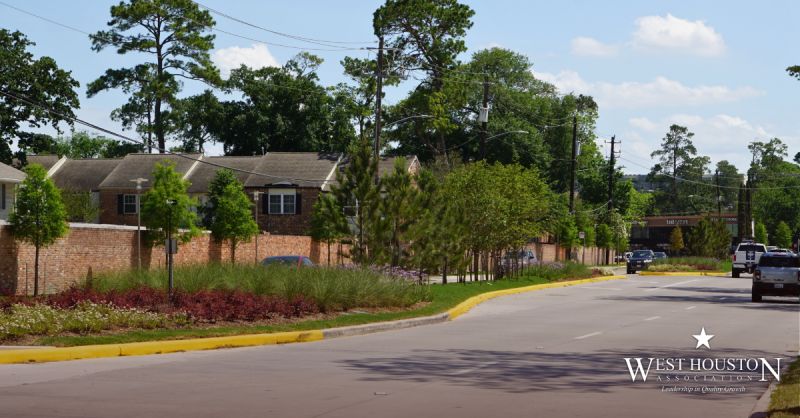
How TIRZs Are Funding Flood Control, Parks, and Mobility in West Houston, Cypress, and Katy
Across the West Houston, Cypress, and Katy region, new parks, improved roads, and upgraded drainage systems are transforming how residents live, commute, and connect with their neighborhoods. Behind many of these projects is a funding mechanism most people have never heard of: the Tax Increment Reinvestment Zone, or TIRZ.
A TIRZ is essentially a self-sustaining neighborhood investment plan. When the City of Houston establishes one, it “freezes” the property tax base at its current value. As new development and improvements boost property values inside the zone, the additional tax revenue — called the “increment” — is reinvested back into that same area. That means the money generated by local growth funds local projects, without raising tax rates or creating a new tax.
For West Houston Association members and stakeholders, understanding this process isn’t just about policy — it’s about tangible, day-to-day impact. The nonprofit, founded in 1979, has been a leading voice for infrastructure planning, mobility improvements, flood control, and sustainable development across a service area that now encompasses more than 1.8 million residents in one of the fastest-growing parts of the Greater Houston region.
Representing developers, engineers, planners, educators, and community leaders, the Association works to shape strategies that make life better in the communities where people live, work, and play.
How TIRZs Impact the West Houston Region
While TIRZs exist throughout Houston, they’ve been especially impactful in Memorial City, the Energy Corridor, and other West Houston economic hubs. In Memorial City, TIRZ funding has supported street expansions, pedestrian-friendly sidewalks, enhanced lighting, and green space improvements that benefit both local businesses and residents.
According to the West Houston Association, “This self-sustaining cycle makes TIRZs a unique funding mechanism. Public infrastructure and improvements financed by the TIRZ attract private investment, which boosts property values and creates even more revenue for reinvestment.”
Mobile Sidebar Ad
For Katy commuters, TIRZ-backed mobility upgrades along major corridors have eased traffic flow and improved access to commercial centers. In Cypress, drainage improvements and detention basin projects funded in part by TIRZ investments are helping protect homes and businesses from repeat flooding — a top concern since Hurricane Harvey.
As the Association explains, “By design, this mechanism concentrates resources back into the neighborhood that generates them, creating a cycle of improvement.”
What Can a TIRZ Fund?
TIRZ dollars are earmarked for public infrastructure and capital improvements — think roads, intersections, water and sewer systems, flood control structures, street lighting, parks, trails, and streetscapes. These investments often mean a neighborhood gets much-needed upgrades years ahead of schedule.
In West Houston, Cypress, and Katy, that can translate to:
- Safer intersections near schools
- Wider lanes and turn bays on high-traffic commuter roads
- New or expanded hike-and-bike trails connecting neighborhoods to retail and parks
- Drainage projects that protect both property and peace of mind
Currently, Houston’s combined TIRZ projects account for more than $270 million in capital investment, representing nearly half of the city’s non-enterprise-funded public infrastructure budget.
“This framework ensures that TIRZ funds are invested according to a publicly adopted plan, with oversight by the City,” the Association notes. “When properly governed with transparency, TIRZs are a powerful tool to finance public infrastructure and spur economic development in specific community areas.”
Mobile Sidebar Ad
Why the West Houston Association is Paying Attention
The West Houston Association has long advocated for strategic, well-governed infrastructure financing tools. By educating both the public and decision-makers on the potential of TIRZs, the Association ensures that growth in the region is matched by improvements that make communities more livable.
In practical terms, that means convening developers, engineers, civic leaders, and residents to shape project plans, monitor accountability, and align infrastructure with long-term regional goals. The Association’s reach extends from the western edge of the Inner Loop to the Grand Parkway, ensuring that its influence is felt across diverse neighborhoods and economic corridors.
As the release points out, “For city leaders and community stakeholders, the appeal of a TIRZ is that it creates better streets, utilities, and public spaces now, which leads to a stronger tax base in the future.”
A Cycle of Local Reinvestment
Once a TIRZ is established and projects begin, the resulting improvements often attract more private development. That, in turn, boosts property values further, creating more revenue for the zone to reinvest — a positive cycle that benefits both current and future residents. Eventually, many TIRZs expire, returning their now-expanded tax base to the city’s general fund, where it can benefit the entire Houston area.
For residents of West Houston, Cypress, and Katy, the takeaway is simple: when you see new sidewalks, smoother roads, better drainage, or a new community park in your neighborhood, there’s a good chance a TIRZ played a part.
And as the West Houston Association continues to advocate for smart growth, these zones may be one of the most effective tools in the region’s development toolkit — quietly transforming communities, one infrastructure project at a time.
Stay connected with My Neighborhood News for future updates as we explore how TIRZs and other special districts are driving change, from revitalizing underserved areas to supporting booming commercial corridors in Greater Houston.
 Tiffany Krenek has been on the My Neighborhood News team since August 2021. She is passionate about curating and sharing content that enriches the lives of our readers in a personal, meaningful way. A loving mother and wife, Tiffany and her family live in the West Houston/Cypress region.
Tiffany Krenek has been on the My Neighborhood News team since August 2021. She is passionate about curating and sharing content that enriches the lives of our readers in a personal, meaningful way. A loving mother and wife, Tiffany and her family live in the West Houston/Cypress region.






